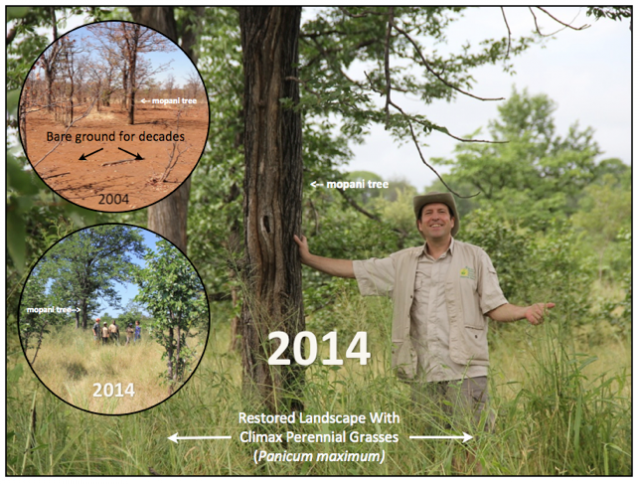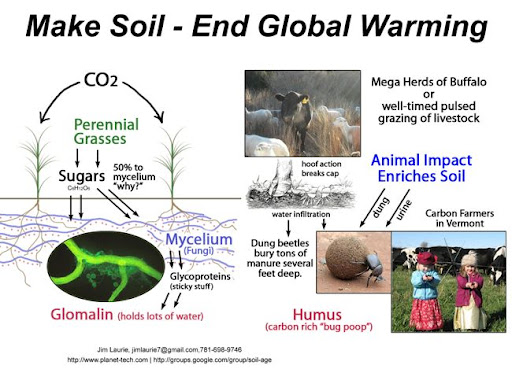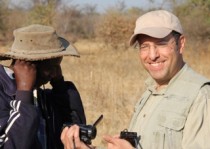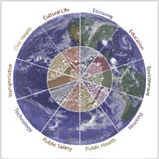You are here
A message from Zimbabwe: regarding McPherson, Savory, Grasslands, Climate, Hope

"Savory’s ideas about employing livestock to fix carbon have been widely and thoroughly debunked by scientists. Using a nonnative species and a source of methane emissions to remove grasses and other plants in the name of carbon sequestration makes no sense."
- Guy McPherson, Posting to the 350MA list, March 24, 2014.
Hi Friends,
I’m writing you from Zimbabwe now, as I think you know. The Internet ranges from poor to nonexistent, especially in the rainy season when cloud cover interferes with the satellite connection.
In order for me to write anything of substance, I need to create it first off line, and then cut and paste when I have a good connection, and if I want to upload a photo, then I need to get a wired connection, and there is only one drop that I can use – which has been setup for me – and only during working hours. This drop runs outside the window of the computer closet and dangles over a table. If I attempt to use it during the high point of the day, I bake in the heat and the glare makes it almost impossible to see the laptop screen. If I attempt to use it later, say between 5 and 7 PM, I am eaten alive by mosquitoes, some of which may carry malaria. I can’t stay after 7pm because then it’s dark and the lions and hyenas come out. Argh.
So, I hope you get a sense of and appreciate the reality here. Even to read the 350MA posts requires me to download a thread and read offline, although occasionally the connection is good and I can read and respond on the spot. Needless to say, this isn’t one of those times!
I also hope you can appreciate the profound feelings I have about the topic of grassland restoration for carbon capture and how every off-handed comment that anyone makes, from someone on this list, to McPherson himself, could easily illicit a lengthy and scholarly reply, which just isn’t possible at this point, and thus a source of frustration. Nonetheless, I wouldn’t change all these hardships for anything in the world. To stand in a grove of climax grassland plants (such as Panicum maximum – that’s roots can be meters deep) under a mopani tree, and on soil that is dark and full of bugs, water, fungus, and organic carbon molecules, in the middle of what was once a semi-desert (and void of carbon), is an experience of such reward, that nothing can detract from it. It is such a palatable vindication of this method, that the dismissive and miscast scattershot that comes from the Internet is so bewildering to me, I sometimes wonder if I and the detractors are on the same planet. I am standing in the evidence of efficacy, and they have their heads buried in studies that don’t even approximate the methods at use here. So, which do you want – the miscast studies, or the reality – grass, soil, bugs, water, carbon captured? Oh, and yes, let’s not forget the dominant players in this transformation, livestock (heaven forbid!), or I as like to call them – ruminants, properly managed according to evolutionary principles to restore the ecological balance on grasslands that was lost through agriculture, improper animal husbandry, and the decimation of the once prodigious herds. Take your pick. Soil or desert? Climate mitigation or climate exacerbation?
Below are pictures taken just two days after McPherson’s post to this list, and pictures of the same spot taken in 2004, 2005, 2006, and 2013. The land is recovering because the livestock concentration was quadrupled, while the grazing plan was radically changed – from conventional “continuous” grazing (or a few animals here and there), to Holistic Planned Grazing (HPG) – many more animals, moving as a group, according to a carefully controlled plan. This second approach mimics the beneficial behavior of wild ruminants herds that has been lost (and is entirely unlike conventional grazing management).
[Pictures show robust biodiversity on restored landscape in Zimbabwe (“Two Tree site”) that was for decades a virtual desert. Restoration occurred through the reintroduction of animals - livestock - managed as a facsimile of wild herds, providing trampling, grazing, and dunging impact essential for arid-area grassland vitality. Photos: Top Row - root systems of perennial Heteropogon contortus, Bottom Left - seed head of climax perennial, Panicum maximum, Bottom Right: ground cover with millipede and fungus. Photos copyright 2014 Seth J. Itzkan.]
Photo credits: ACHM, Seth Itzkan. Composition image copyright 2014 Seth J. Itzkan
[This time-series sequence shows the transformation from a barren landscape in Zimbabwe to a healthy grassland savanna from 2004 to 2013. Average annual rainfall is 600 mm. This is referred to as the “Two Tree” site because of the adjacent two trees in the center background. The land, which had been barren and eroding for decades, is “treated” with a heavy concentration of animals. About 500 cattle are corralled on the site for 7 to 10 evenings, leaving an excessive amount of dung and plant litter. Within one year after the animal treatment, short-rooted annuals start to grow, such as aristita (the white stringy plants – 2005 photo). With the emergence of these plants, the land is thus incorporated into a carefully monitored grazing plan. After only a few years, the annuals and first succession perennials (chloris, urachloa) are densely packed. These provide “ground cover” that helps retain moisture and builds biodiversity in the soil (2006 photo). These annuals and early perennials are a first-phase in the restoration, but their carbon capture will be minimal. After about 8 years, however, deeper-rooted perennials appear (Heteropogon contortus, Panicum maximum, 2013 photo). These accelerate the carbon capture which can continue for decades.]
For those who are interested in the supposed discrediting of Savory, as referred to by McPherson, this miscast is based almost entirely on a single paper by Texas A&M professor David Briske (often recited by Briske himself). This paper, however, has now been discredited, even by a fellow colleague at A&M, Richard Teague. As it turns out, Briske, did not actually do research on HPG, but only compiled studies on “rotational” grazing, and then made a monumental error by claiming those studies were representative of Savory’s HPG. As Teague showed, they were nothing of the kind. Of the studies cited by Briske, not one, repeat, not one, was HPG nor even similar. Almost all were “fixed” grazing regimes and of the few that were “adaptive”, they were so minimally as to be of no consequence. No studies ever integrated continuous monitoring and adaptation for ecological performance, which is a hallmark of HPG. The difference between what HPG is, and what is cited by Briske, is so large, I am bewildered by Briske’s actions and honestly question the intentions.
Fortunately, a new generation of range scientists is emerging who are not dissuaded and can see for themselves the obvious improvement of land where livestock are managed properly and are doing studies that actually assess HPG. They understand that HPG is not a “grazing system”, it is a planning process (which follows an “aide memoir”). The actual grazing plan will thus be different on each ranch (in each season) and will be continuously changing, according to conditions on the ground. This fact, so basic to the concept, is remarkably lost on Briske. Such is the distinction, I am learning, between academics and practitioners.
Those who are interested in the nuances of this “debate” can read more about it on my website, here. If you have any questions about specifics, I am happy to help answer. In the scheme of things, however, this is a side issue among academics (and entrenched activists). For land managers, the efficacy is becoming increasingly clear, and for the shrinking base of detractors, they are just going to have a harder and harder time defending their position, especially when so much is at stake, regarding the environment, our climate, and the welfare of humanity.
Grassland recovery = Climate change mitigation
Much love from Zim!
Seth
(in Zimbabwe)
- admin's blog
- Log in to post comments



